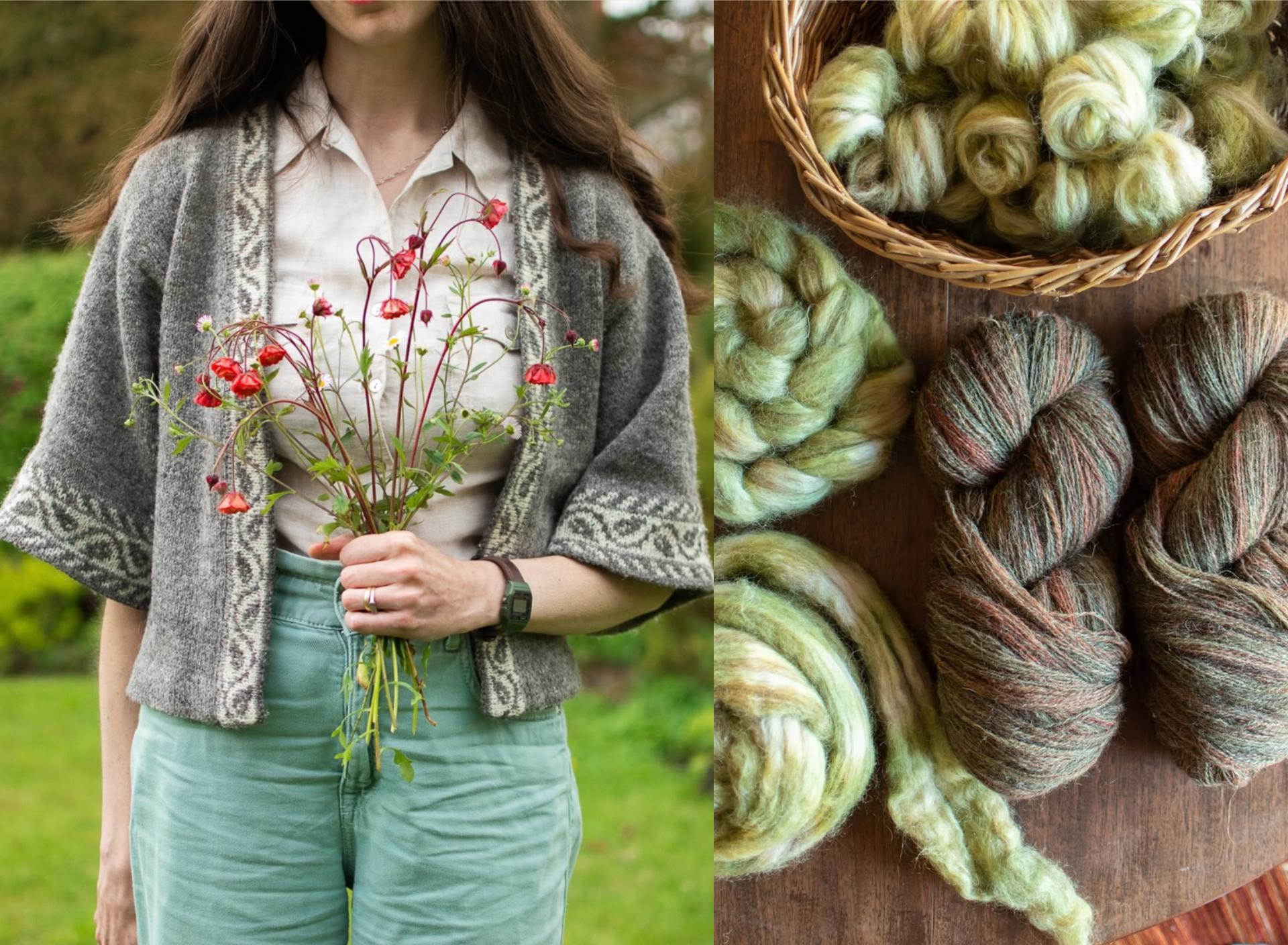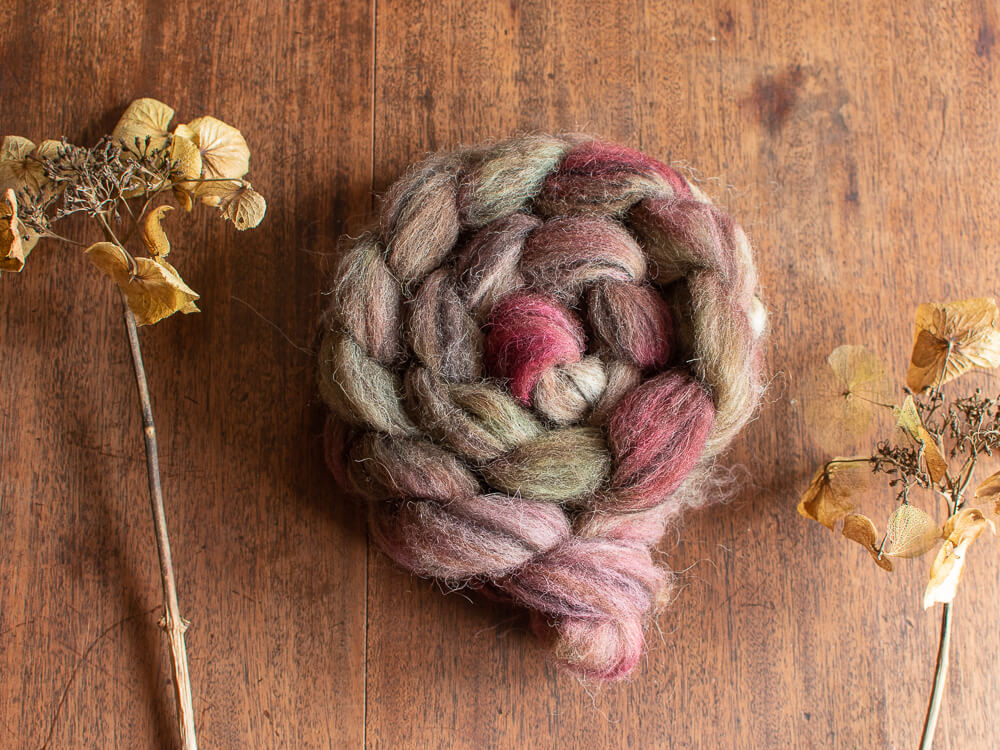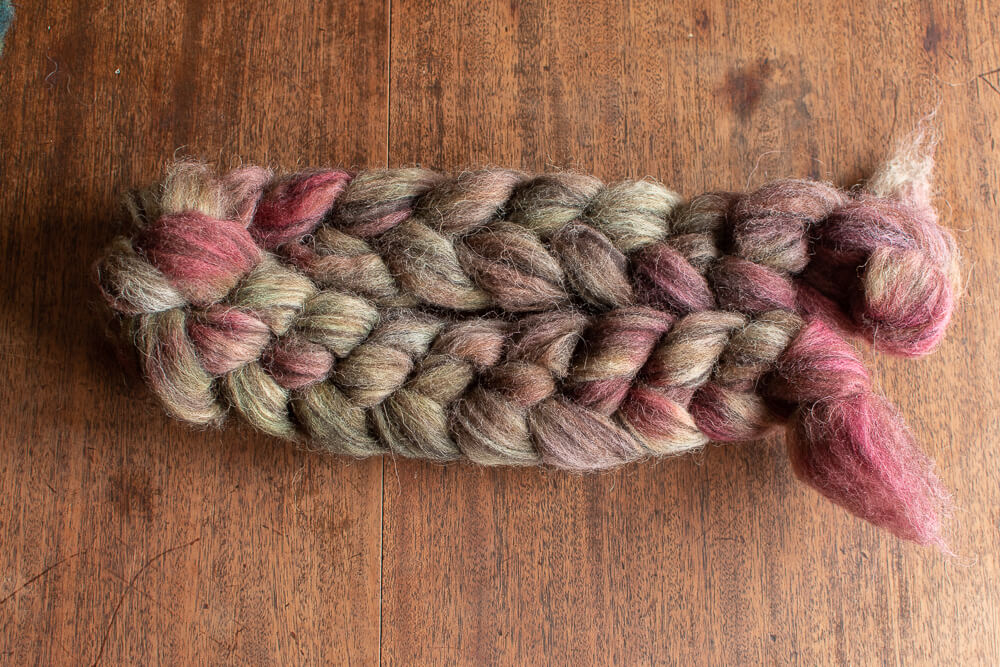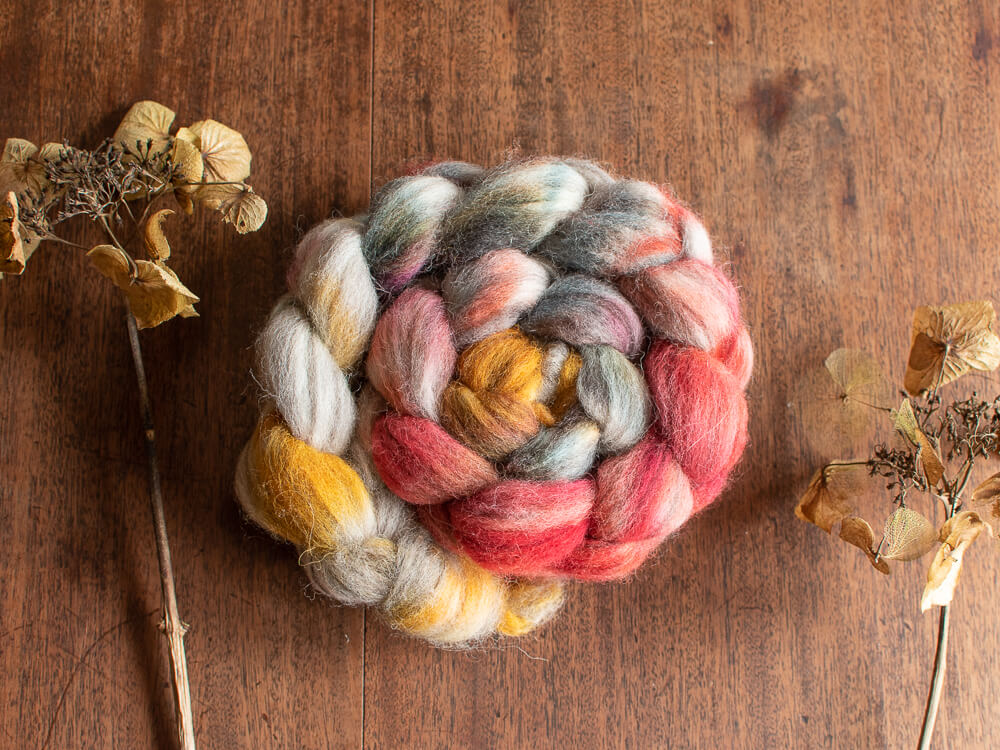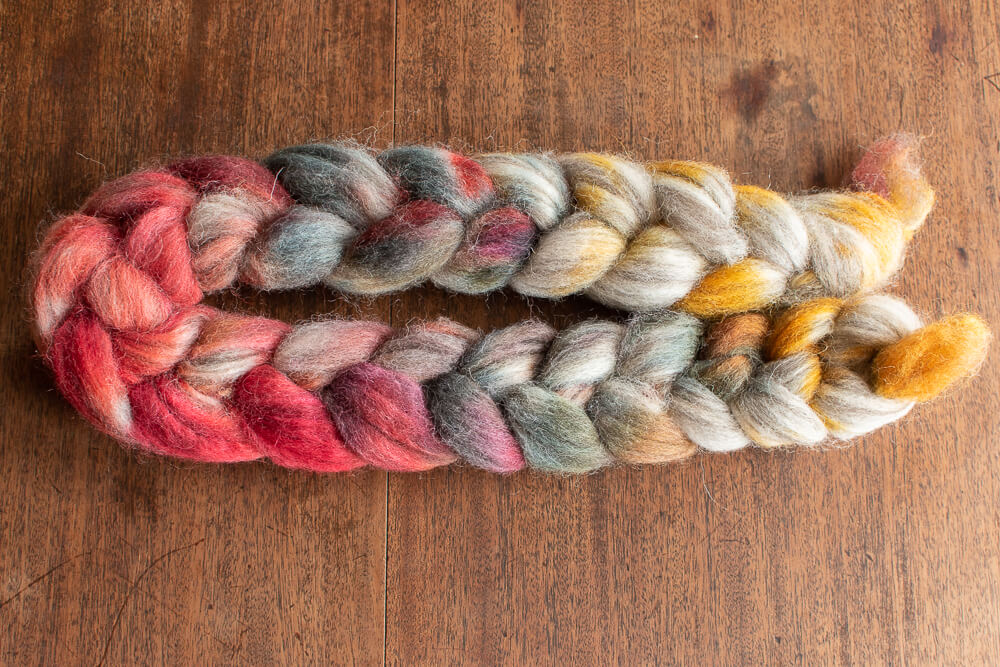A relaxed and somewhat lengthy chat, answering your questions about my crafts, knitting, spinning, dyeing and weaving.
Answering all your about my creative, craft-filled life
All my current craft projects are at stages where I can’t really show off any progress, so we’re doing something a little different today. It’s been a while since my last Q&A - let’s catch up on my creative, craft-filled life so far.
How did you get into crafting, and what was your gateway craft?
Crafting has always been a part of my life. Growing up in a family where making things was a regular activity, I was encouraged to help with repairs and mending as soon as I was able. My mother did some knitting, crocheted and dabbled in embroidery, but the mending pile was an ever-constant. So, in terms of gateway craft, I think I’d say sewing as it was the most practical for me.
Over the years, I’ve done a lot of crafts, always needing to keep my hands busy, but after a couple of reintroductions, knitting took over when I went to uni. It’s far more portable than sewing, not to mention affordable, and suited my student-sized accommodation slightly better than a big sewing machine!
Do you have any plans for other ambitious craft projects, like your hand-dyed, hand-spun, woven skirt you sewed?

At the moment, I have a couple of ambitious projects on the go. The first, I touched upon in the last podcast blog, but I have spun up some of my hand-dyed spinning fibre on my skua base, and am currently spinning some feather blend in a pale green to weave with it to create some sort of handmade garment.
The other craft project is even more ambitious and has been going on forever. I’ve been documenting the process on my Patreon, but so far, I’ve naturally dyed some British wool fibre, and have processed a batch of locally grown flax and will be blending them to spin, weave and sew something currently undetermined.
How did you get started with Fibre Arts?

Crafting can snowball quickly... I learnt to knit, then discovered the art of spinning, and soon I was teaching myself how to weave too!
My work with fibre arts probably started snowballing in late 2015. I had some fibre-reactive dye leftover from a super fun tie-dye session with my husband, and I thought I would try using it up by dyeing some undyed cream wool that I had inherited. Just as an experiment, I laid out the yarn in the bath and started splashing some dye on it. I had absolutely no idea what I was doing, but I knew that I was immediately hooked.
Around the same time as my hand-dyed yarn experiments, I also learned that you could spin yarn using a drop spindle. I went to my local yarn store and picked up a drop spindle and a bundle of spinning fibre from a range of sheep breeds to try spinning my own yarn. I was terrible to start, worse than average, although I like to think I’ve improved since then!
Once I got to the point in textiles that I could think, not only about the yarn and what I could turn that into, but also designing the yarn itself, from scratch, that was me gone. These multifaceted craft projects are super fun for me. I get bored doing the same thing over and over, whereas these allow me to engage with all the different processes from start to finish. It does generate a bit of a snowball, though and after starting to spin, I eventually took on weaving - I had so much hand-spun yarn to knit with, and weaving meant I could work through my stash much faster.
How did you start out with your small craft business?
My craft business wasn’t necessarily something I set out to achieve, but something which evolved over time to work for me. I like to have a lot of flexibility in my creative work and what I do in terms of running a small business. That’s why I’m not just a knitwear designer, yarn and fibre dyer or crafty podcaster. I like to have lots of things going on to keep everything interesting for me.
I stepped a toe into the small business life as a teenager, selling beaded jewellery on eBay, and later moved on to selling leather jewellery on Etsy made from samples from upholstered chairs and sofas that came from my parents' interiors business. As I got more into knitting, I eventually transitioned into selling handmade baby booties, but it wasn’t until I began hand-dyeing yarn in small batches that things started to get more serious.
I started selling the yarn I dyed in 2016 while working full-time, but when the opportunity to work part-time at Fernhill Farm came up (where I now source the wool for my Mendip yarn), I took advantage of the flexibility and security of that to support my yarn dyeing as a small business venture.
Once my own stuff took off, I was able to step away from Fernhill to focus entirely on a mixture of yarn dyeing, knitwear design and tech editing. Like I said, my creative business is flexible and works for me and evolves with me, so I’ve also expanded my offerings to include handmade wooden buttons by Tom Dyson, and I’ll have more exciting things to reveal very soon. I’m always working things out as I go, and that’s very fun to me.
How do you approach your choices of materials for creating your handmade wardrobe?
A lot of my slow craft projects, where I am dyeing the thing, spinning the thing, weaving the thing or knitting the thing, are based on what I have in stash. This is my small business, so I have a lot of yarn, own a number of fleeces and have a collection of hand-dyed fibre from using up leftover dye in my dye pots, too.
I have a very good memory, which means I can trace pretty much all of my yarn and fibre, and I like to keep remnants of everything. The connection to the memory of the material is very much a factor in what I choose to create with, like using alpaca fleece I got while visiting a weaving studio with my grandma, for instance. It means something to me, and that makes that particular craft project even more special.
With some craft projects, though, I will stray from my yarn stash and deliberately seek out local fibres. I did this with my West County Collection of knitting patterns, where I visited local farms that were specifically producing undyed British wool to create 5 unisex knit designs. Visiting farm shops and even meeting the sheep themselves is a great way to connect with the fibre industry and the landscape and something I’d encourage everyone to do.
Do you like to make things for the home as well as clothes?

I might finish my scrappy handspun yarn project one day!
I used to make woven tapestry wall hangings, something I think would be a really nice form of creative expression if I decided to develop it more, but it’s not something I would incorporate into my creative business. I prefer being part of a crafter’s processes, rather than selling a finished item. There’s something so lovely about the idea that I can take a craft process so far and someone else will take it further, knitting the yarn, spinning the fibre, etc.
I do have a long-neglected craft project where I am shredding yarn scraps to spin into a yarn, to then weave into a rug that will happen eventually, but generally speaking, my preference is making and designing garments and things I want in my handmade wardrobe. Homewares feel somewhat static to me. Not everyone is the same, but I don’t change up my home aesthetic often - I will decorate for Christmas, and that’s it. The other 11 months of the year, the decor is the same! Clothes, on the other hand, are far more fun and interesting because I get up and choose what to wear every single day - there’s way more scope to it.
What is your favourite aspect of your craft? Design, spinning or knitting?

Depends on the day, week, month, year, even! I find weave(!) in and out of different crafts, giving some a bit of breathing space until I eventually come back to them. Right now, I’m working on new knit designs, but they are all previous knitting projects I have returned to. I love all aspects of the creative process, from designing to spinning to knitting, but I’ve learned to give myself space to revisit things when the excitement ebbs and flows in order to maintain that balance and enjoyment.
How did you find the confidence to start making knitting patterns and podcast videos?
I started designing knitting patterns while I was at uni. I discovered Ravelry fairly quickly in my reentry into knitting, but when I struggled to find the designs I wanted to make, I began modifying existing knitting patterns to make them my own. I experimented with swapping out cables and stitch patterns and became curious, looking at existing knitwear pieces and thinking, ‘how can I recreate that?’
It had me approaching knitwear creatively, so when my friend, Becca, randomly sent me a call for submissions for scarf designs from Quince & Co, I used it as a sort of canvas for a stitch pattern I was working on, combining ribbing and cables and sent it off. Initially, I thought nothing of it because why would they pick my design? But to my surprise, it was accepted! I think it was a gentle way to begin designing knitwear, starting with a scarf rather than a handknit jumper, much more of a low-stakes project.
Tech editing in my early career also exposed me to different ways of designing knitwear, and I became very competent at checking numbers, which infinitely helped my confidence as a knitwear designer.
As for my podcast videos, I had been sharing on Instagram stories for a while, which went down well. I had already done a bit of public speaking, so the concept of an audience, so to speak, was not too daunting. I am quite wordy when it comes to communicating in written form, and I find that I can come across as quite dry on the page. As such, it’s difficult to adequately convey my enthusiasm for things. I am so deeply passionate about my work, and (obviously!) I want that to come across - chatting about things in person felt like a way to do that.
My first videos are janky as hell, and you can tell how nervous I am. I still say ‘um’ far too much - it annoys me as well! - but, once I got started, I never really stopped.
Is there anything challenging you’d like to design that you haven’t tackled yet?
Absolutely! But nothing concrete as yet. I’m continuing to build my craft skills, always focusing on keeping things interesting for myself.
There are always challenges to overcome - getting myself to finish knitting a sample for one. There are knit designs I would love to exist in the world, but know I wouldn’t get through knitting myself. Like a complex, all-over crisscrossy cable design. I would love that, but I’m not sure I could convince myself it would be fun or worthwhile when it comes to knitting pattern sales at the end.
But a big obstacle in knitwear design is grading knitting patterns. I believe everyone should be able to knit things that fit their bodies and I’m committed to size inclusivity as much as possible in my work, but certain designs don’t always work for all body types and proportions. Good grading isn’t just a case of adding more stitches - there are some things I could design for my own (smaller) body, that just wouldn’t quite grade out.
I try to make things fit as best I can with the understanding that different bodies have different proportions. Like myself - I have comparatively very long arms, a short body, and ridiculously long legs, and despite being quite skinny, I'm also somewhat curvy. I am aware of the kind of body I have, and I have learned to make changes for that when knitting, but I don’t design specifically for that. I’ve learned to design for standard charts, which is why sometimes the sleeves of the samples I knit are too short for my overly long arms!
What comes first: the type of knitted garment you want to design or the stitch pattern?

The swoopy cable pattern on the Welanna sleeve
It’s a bit of both! Sometimes I start with a stitch pattern that inspires me, like herringbone stitch, and think about how to incorporate it into a design - to be honest, I think I’m often thinking ‘how can I get herringbone stitch on here’ because it’s so interesting! Other times, they happen in parallel, like with Welanna and Valley Rooves, but most often, I come up with the concept first and then choose a stitch pattern that fits.
As a knitwear designer, do you ever find that your inspiration pool has dried up? If, or when, what do you do to refresh?
Fortunately, I don’t have to go casting about for inspiration; rather, it comes to me perpetually, and I have to shield myself against it! Every so often, though, when it feels less abundant, rather than trying to push it, I take a step back and work on other things. I have a mental back catalogue of ideas that I can revisit when the time is right, some sit for years before being retrieved.
If inspiration is lacking. Pinterest! I love Pinterest and could make Pinterest boards all day. I have an ongoing catalogue of many, many moodboards, some of which are very interesting to say the least - my personal style board has King Theodin on it, and do you know what? I don’t know what the logic is either! But, going through boards that date back years can be a real help in getting creative ideas going again.
When, why, and how did you start spinning?

Making my own yarn from scratch, designing it and spinning it is super cool to me
I’ve already covered the how, with the drop spindle and set of fibre samples from my local yarn shop. And, actually, that is precisely why I have my own British wool fibre sample boxes on the website. I started spinning in 2015, and as for why, well, because why not?
After seeing all the pretty yarns spinners were creating on Instagram, I just wanted to spin my own. When it comes to spinning, I’m not especially technical, preferring to work off vibes, but it’s the idea of creating my own handspun yarn and then being able to turn that into something else which is just super cool to me.
What made you decide to start hand-dyeing your own spinning fibre?

The hand-dyed Skua blend that became my hand-spun skirt (and the springboard for me to sell my own hand-dyed spinning fibre)
I started dyeing with my current blends of spinning fibre after Wingham Wool reached out to me, asking if I wanted to create my own British wool fibre blend in collaboration with them. I designed the Skua blend, which both they and I now stock, and, as part of that, they gifted me a kilo for personal use. Just so you know - a kilo of fluff is a lot of fluff!
I thought I would try dyeing a couple of hundred grams of it, which later became my handspun skirt. As I shared it, people were so excited about it that I bought in some more fibre to dye and sell, and it sold out very quickly. Not wanting to tempt fate, but that’s been happening ever since!
What is your most enjoyable fibre prep to spin? What is your favourite of your own British wool fibre blends?
It’s tough to choose a favourite - it’s like asking me to pick a favourite child! They’re all created for very different things, but if I had to choose, I think it would be my Skua blend because that’s what I designed it for; it has all the qualities I most love in wool for spinning. I’m spinning with the Feather blend at the moment, and it is so sleek and lustrous and really quite pretty. I’m having a lot of fun with it. My Solace blend is kind of the opposite - it’s really bouncy and cloudy, and when I use it as a base for hand-dye, all of the colours look very matte on it. All very chilled and calm, which I quite like. Tilth is my most recent addition and is so floofy and bouncy and soft. Each blend has its own personality, which is what makes them so lovely to spin up.
In terms of general fibre prep, I do like spinning from wool top because it’s much easier to spin more smoothly and evenly, but the kind of yarn I really like making is where I blend lots of different fibres. I’ll always do this on my drum carder, because that’s just what I have, but I’ll take the batts and draft them into a kind of faux wool top, trying to get all the wool fibres aligned before drafting that out and splitting it into little nests.
Because I often blend local fleece I’ve scoured and processed myself, this is such an enjoyable process. It usually has less consistent preparation, which leads to less consistent yarm, but somehow that is more engaging and soulful and a creative process I just love.
Do you have any new projects or plans for your Fibreshed work?
I published From This Land: A West Country Collection at the end of last year, which was a collection of knitting patterns I worked on, supported by Fibreshed. The PDF contains five knitting patterns, all designed using locally sourced British wool. Each pattern includes a very abbreviated story of my visit to each farm and how they inspired my knit designs.
I’ll be releasing the patterns individually closer to autumn, because I don’t want to be promoting a DK cabled cardigan in May, and I’m potentially going to turn the collection into a physical knitting book, so watch out for that.
The project I mentioned at the very start of this (rather long!) Q&A, where I naturally dyed some fleece and processed some flax, would technically be a fibreshed project because all of the dyes and fibres involved there are sourced here in the West Country in the South West of England. I’m also working with Zwartbles fleece from a farm just a couple of villages away. I’ll be sending that off to a mill down in Dorset. But in terms of official collaborations with Fibreshed, there’s nothing currently in the works.
What are your favourite knitting needles?
Knitpro Mindful. I started with an interchangeable set from Knit Picks that begins at a 3.5mm, but now, all the knitting needles I buy are from the KnitPro Mindful range. They’re compatible with my Knit Picks cables, super sharp (which I love for cables and increases), and just feel like better quality overall.
I pretty much exclusively use interchangeables, but for needles smaller than 3mm (which won’t work with my KnitPro/Knit Picks system), I use Chiaogoo Red Lace.
Do you have a favourite type of wool?
I don’t even know how to start answering that! In terms of sheep breeds, i’d have to pick Shetland. I love all the natural colours, and I like how versatile the fleece can be—some finer, some coarser. I’ve worked with loads of Shetland fleece and yarn over the years, and I’d say most of the yarns I have worked with probably have some Shetland in them.
So, yeah! This has been mega fun, definitely a longer blog than my usual, but I hope it’s been an enjoyable read. If anything resonated with you in particular, I would love to hear.
Hopefully, I’ll do another Q&A in the autumn.
Catch you next time! x

